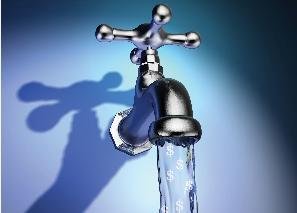Water disinfection is critical to supplying clean, safe drinking water; many technologies and chemistries exist to aid water system managers in the task of supplying clean water. Ultraviolet disinfection, ozonation, and filtration are often employed. Additionally, chlorine is widely used; well known for its ability to disinfect water, chlorine was perhaps the most common means of water purification in the last century. One group of chemicals that is gaining in popularity are chloramines; chloramines are a potential alternative to chlorination that have been in use for decades, but some have questioned their use.
Chlorine, while widely used, has some drawbacks. Namely, free-chlorine in a water system will tend to react with other minerals and compounds in the water and the piping. This reactivity, while critical to the way in which chlorine attacks pathogens, limits its use in large water supply systems. In these large, far-flung systems, additional chlorination facilities must be used to add the chemical to the water in order to ensure that pathogens do not have the opportunity to reproduce in the water system. Chloramine is significantly more stable in water systems; it maintains reactivity with pathogens, destroying them, but resists undesirable reactions that would reduce its efficacy.
Chloramine (NH2Cl) is created when ammonia is added to hypochlorus acid in a dilute form. In addition to being long-lived in water systems, chloramines in water do not produce a “bleach†smell or taste; this results in improved water taste. While taste is certainly secondary to health and sanitation, many people find water treated with free-chlorine to be unappetizing.
Beyond the basics, when chlorine reacts with other compounds, it can form undesirable or even carcinogenic compounds; these compounds are referred to as disinfection byproducts (DBPs). Some of the most common DBPs are trihalomethanes and haloacetic acids; both of these classes of compounds are recognized as carcinogenic in nature and are regulated by environmental protection agencies, worldwide. While this may seem like a poor trade, the World Health Organization advises that risks to health from DBPs are extremely small in comparison with inadequate disinfection.
On the flipside, chloramines are not without their detractors. Chloramine is toxic in a pure form and the US EPA sets an acceptable upper limit at 4 part per million (ppm); as a result most water systems strive for a ~3ppm target level. Also, while chloramine has been demonstrated to produce lower levels of regulated DBPs, it does produce significantly higher unregulated DBPs. An example of these unregulated byproducts is N-Nitrosodimethylamine which has been deemed to be genotoxic or detrimental to genetic material.
Additionally there are secondary concerns that arise from the fact that many aquatic animals are sensitive to chloramine. Zoos and those who keep exotic fish go to great lengths to chemically neutralize the chloramine in any water that they use. Brewers also argue that chloramine-disinfected water can give beer an “off taste†and, as such, avoid its use in their processes. Chloramines also appear to liberate lead from lead piping; while virtually all new construction is lead-free, older homes may still have lead pipes and this may pose a health risk.
Only time and further study will determine if chloramine is safer than chlorine in water systems. Chlorine and chloramine both have proven track records in water disinfection; both will likely be utilized for years to come. When it comes to evaluating the risks of any method, perhaps the WHO warning summarizes it best – the risks associated with disinfectants are relatively small compared to the risk on not disinfecting water, at all.
- A Comparative Review of Municipal Work Order Systems
- Conferences
- Five Lessons for the Future of Water
- Home
- Latest Bids
- New and Emerging Capital Providers for Infrastructure Funding – Water Research Foundation
- One Water Communication Standardization
- Pagosa Springs restores its potable water system with help from SolarBee® mixers
- Seeking Watertech Distributor – Puralytics
- Sharing Smart Solutions in Water
- The 9th GLOBAL LEAKAGE SUMMIT 2018
- Air Hes
- Polluted Water is Major Killer
- Water Charities
- Water Pollution
- E-bidding
- Reverse Auction Demo
- Unlocking Bid Responses
- Reverse Auction Demo Slide1
- Reverse Auction Demo slide2
- Create a Bid
- Reverse Auction Demo – Vendor
- Reverse Auction Demo – BAFO
- Grant Bid
- About Us
- Conferences 2013
- Kid’s Resources
- Sewer Games App
- Liquid Chlorine bids and Other Chemical Bids
- H2Art
- Editor’s Perspectives
- Clean Water Web
- Agriculture’s impact on water pollution
- Ask An Earth Scientist
- Chlorination – Triggers Heart Disease and Cancer?
- Could Nanotechnology Solve The Water Crisis?
- Drugs dumped into Wastewater
- Groundwater and its contamination
- How to find if a river is polluted
- Lax oversight raises tap water risks
- Mountains of Water
- Ocean Pollution, Industrial Pollution
- Reducing Stormwater Impact
- Safe Drinking Water Challenges
- Should You Stop Consuming Bottled Water?
- Ten ways to reduce water pollution
- Video on Water Pollution
- Wastewater Treatement
- Water Crisis in China
- Water Facts
- Water Pollution
- Water Pollution Causes
- Water Pollution Effects – Chemical Contamination
- Waterborne Infectious Diseases
- Where Have All the Water Fountains Gone?
- Wildlife Waste Is Major Water Polluter
- World sanitation goals slip
- Water Conservation
- H2Watersheds
- Global Warming
- A Primer on Effective Water Utility Management
- Related Links
- Clamp Down on Influent Infiltration
- H2WebTV
- H2 Crossword Puzzles
- Weather Video
- International WaterCentre
- Calendar of Water Conferences
- H2Bid Book Store
- Free Water & Wastewater Trade Magazines
- Water Jobs
- Contact

H2bid Blog
The World's Water Blog

H2bid Blog
The World's Water Blog
